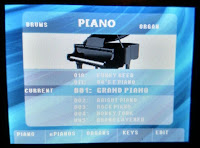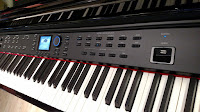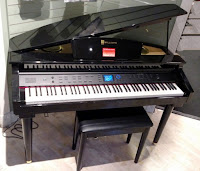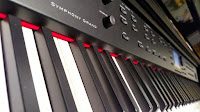🎹 UPDATED REVIEW – June 1, 2023 – Williams Symphony Grand Piano – NOT Recommended – The Williams company is a division and part of the Guitar Center company family of brands and stores which includes Guitar Center, Musicians Friend, Woodwind & Brasswind, Music & Arts, and others. The Williams company does not manufacture its own pianos and the Williams brands is not made in the US. They are made in China by another company and Williams has used their own “Symphony” model name for many years that has represented a different model in the past.
The Williams Symphony micro digital grand ($1699 internet price) is a small “micro-size” digital piano under the Symphony name. Although it has an attractive “micro grand” cabinet with built-in color LCD screen that has many functions, as a piano, in my opinion, it is not even close to the quality and realism of a new $500 Casio or Yamaha digital piano in terms of its piano playing authenticity. In other words, what looks like a good product on the outside, but that does not mean it’s good on the inside.
It’s unfortunate because the factory specs and all the Guitar Center stores and affiliate web sites would lead you to believe it’s an amazing product and something that blows away all of its competition for an incredibly low price….but it simply does not come anywhere close to doing that. Please click on pics for larger views.
When you look at the Symphony piano specs and what it can do “on paper,” it looks pretty compelling with well over 100 instrument sounds, rhythms, and accompaniments, along with nice audio & USB/MIDI connectivity features including Bluetooth, 128-note piano polyphony, multi-track MIDI recording, and a fairly large internal speaker system. But just for a minute let’s put aside these “bells & whistles” and concentrate on the fundamentals of any piano and that is…key action, piano sound authenticity, dynamics, & response, and pedaling. Without having good, solid, realistic piano fundamentals, the rest of what the piano can do and how it looks is,
in my opinion, meaningless and a waste of time & money. Unfortunately that is the case with the new Williams Grand micro digital piano.
Now we move on to the piano sound. This is a fairly complex area of reproducing (in a digital piano) what normally occurs in a real piano. It is done with piano sampling put into computer chips along with key sensors underneath each key to sense the key moment so a sound can be reproduced depending on where the key is located as it is going up & down. In real acoustic pianos there are tonal and volume dynamics and how the sound moves from mellow to bright and soft to loud as the key is being struck and played fast to slow. The piano sound is supposed to have “expression”: and the ability to change tonal color when playing the keys at different velocities or finger

pressure. The piano sound should also be relatively the same tone in brightness or mellowness when moving from one key to the next along with natural and even volume changes.


The dynamic tonal range of real pianos allows each key/note to be mellower (softer in tone) when you are gently playing the key and then that note (string inside a real piano) starts to brighten up as you play the key a bit harder with more finger strength and the tone continues to be more expressive and gets brighter & brighter as you play the key harder and harder. You are NOT supposed to hear big, noticeable jumps in piano tonal dynamics but instead you are supposed to hear subtle and smooth changes in the piano tone when playing a key at different velocities and finger pressure. This is yet another area where the Williams piano sound/key action is of poor quality and realism. First of all, the dynamic tonal range in the Williams Grand is quite compressed and small without a lot of change from mellow to bright piano sound when playing a key, and this causes unnatural musical expression.

Basically there are soooo many negative issues with the piano key action and piano sound that anything else the piano does well is of little value to me including the physical beauty of the piano itself. For people who are beginners, are not taking lessons, or who are not experienced with how real pianos actually play and behave, then maybe you won’t notice these issues and will be happy with this model…and that’s entirely possible….sometimes ignorance is bliss:). But, in my opinion, there really is little excuse for ignorance when spending this much money for a digital piano instrument and thinking you are getting something for nothing as I mentioned earlier. The pedaling on this piano is also basic but there are 3 pedals and they do work OK.
 OK…I know many of you might say that I am being overly negative about this piano and it cannot be that bad? Well…you would be wrong if you said that. I have nothing against the Williams brand or their pianos, but when it comes to the musical satisfaction of piano students and players to realistically (at minimum) play a song and have it come out right and actually sound and respond like a piano, I am quite concerned about that and not concerned about how “pretty” the cabinet is (yes it is), or what a low price the piano has, or all of the “fun features” you can get on the piano.
OK…I know many of you might say that I am being overly negative about this piano and it cannot be that bad? Well…you would be wrong if you said that. I have nothing against the Williams brand or their pianos, but when it comes to the musical satisfaction of piano students and players to realistically (at minimum) play a song and have it come out right and actually sound and respond like a piano, I am quite concerned about that and not concerned about how “pretty” the cabinet is (yes it is), or what a low price the piano has, or all of the “fun features” you can get on the piano.
Now…on to the digital features. The Williams Symphony Grand micro digital piano has an impressive color LCD screen with lots of information on it. It is not a “touch screen” but operates by pressing buttons below and to the side of it. The control panel itself has a blue back-lit dial controller on it which allows for easier control of the sounds, rhythms, and other digital features and it works quite well in accessing the features. In terms of instrument sounds, the Williams Grand has 174 of them including pianos, electric pianos, organs, strings, brass, woodwinds, guitars, special sound effects, and a variety of other instrument tones. Some of the instrument sounds are realistic and others are not. The piano sampled sounds overall
are good although they are a little thin sounding, but they suffer from the many inconsistencies and issues I have previously mentioned.
As for auto accompaniment features, this piano has a lot of them. There are 120 different rhythm accompaniment patterns which allows you to play along with different drum rhythms including rock, jazz, Latin, country, swing, waltz, country and many other music styles. Auto-accompaniments add the music backgrounds to these rhythm patterns that allow you to play a left-hand chord and have a one man band playing along while you just play chord progressions or arrangements. So whether yo are a beginner or a pro, playing along with ensemble auto-accompaniments is fun and
it makes you sound better than you are. The downside of this feature on the Williams Grand is that many of the rhythm arrangements are pretty bad.
Other features on this piano include the ability to layer two sounds together at one time such as piano & strings, organ & harpsichord, etc, splitting two instrument sounds with one on the left hand and one on the right hand, a digital metronome WITH tempo speed control for use when learning a new song and needing help with keeping the proper rhythm and timing, a 4-track digital MIDI recorder to record what you are playing and then play it back later, and a transpose feature so that you can play in any key when you digital change that key with by modulating or transposing it electronically. So the Williams Symphony is certainly not lacking in digital features and they are fairly easy to access.
The Symphony grand can also play back General MIDI song files off a USB flash drive which is nice to have and can make it fun to learn songs but there are limitations to this feature that other General MIDI systems don’t have. The piano has an audio input jack so that you can run an external audio device through the piano speaker system to hear songs and play along with them. There are also audio output jacks so that you can connect this piano to an external audio speaker system which is nice. A Bluetooth MIDI feature is built in to allow for connecting external USB/MIDI devices such as iPad to the piano with the need for cable
connections. Bluetooth is definitely the way to go but connectivity isn’t always guaranteed because of the wireless component of the connectivity which can drop out from time to time based on my experience with Bluetooth on some digital pianos.
The piano cabinet comes in a shiny polished ebony and measures about 30″ from front to back and is considered a “micro” digital grand piano in size and form. The inside of the cabinet under the lid is wood tone so it contrasts nicely with the polished ebony finish. The cabinet also has a nice music rack to support the music and a sliding key cover that closes over the keys. It has a lid that props up into place which looks good, 3 piano legs with brass trim at the bottom of the legs, a full 3-pedal lyre, and the piano comes with a matching bench. There are 6 speakers built into the piano and the overall piano volume is sufficient and loud enough for most applications.

The bottom line is…you normally get what you pay for and this is definitely true with the Williams Symphony Grand digital piano. For a selling price of $1699, it seems like a great deal for what it appears you will be getting, but is it really great? The answer is a definite NO. What you actually have here is an attractive fun music toy in my opinion and not much more than that. For the uninitiated and easy-to-please crowd, the Symphony may be a good piano for you if this is what you are looking for and are not a discriminating person when wanting an instrument which plays
 more like a real piano, because this model just doesn’t cut it at all in that way.
more like a real piano, because this model just doesn’t cut it at all in that way.

If you like the new Williams Symphony, regardless of what I have said, then buy it…it’s your money and it may indeed make you happy particularly if you are a beginner and don’t don’t what a piano is supposed to play or sound like. One of the big things I have noticed when it comes to deciding on which piano to buy is that sometimes there will be some great piano player doing a video/YouTube of these pianos and those piano players make these pianos sound really good. That’s actually pretty easy to do because
a person who plays really well can make ANY piano sound good, no matter how bad that acoustic or digital piano may be otherwise. I can do it too and know what it’s like.
There is a reason why other high quality smaller digital mini grand pianos cost more money. When it comes to getting a good playing piano, the Williams Symphony micro grand
is not $1699 for no reason. When you sacrifice piano playing quality and realism to get a low price, then the buyer needs to beware what they are losing for spending a lot less money. In my opinion, on the Symphony Grand, you would be losing way too much in a quest of having a cute ebony gloss micro-grand cabinet, some fun features, and built-in color display screen. If you are buying an instrument for a piano student or someone who plays recreationally then in my opinion you are sacrificing their ability to play the piano correctly and learn and play with good technique and expression (important stuff) just to get a low priced good looking cabinet that fits in a nice small corner of the home and has some “bells & whistles.”
If you want more info on new digital pianos and LOWER PRICES than internet discounts, please email me at tim@azpianowholesale.com or call direct at 602-571-1864.














What about Artesia AG-28 Micro Grand Digital Piano
I have done a review of that model. Go to the following link: https://azpianonews.blogspot.com/2014/10/Artesia-AG28-Artesia-AG40-REVIEW-Digital-Grand-Pianos-Costco.html
I guess that If you don't have anything at least good in your mind on a product, then don't say any fault comments on something!!! You are just as bad as you said about the piano in your own review…